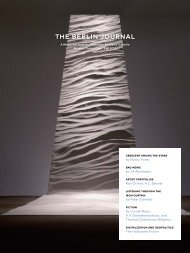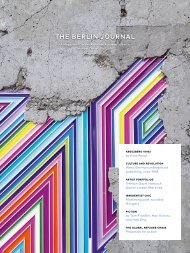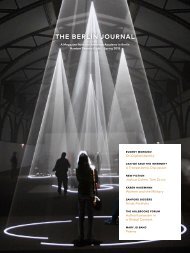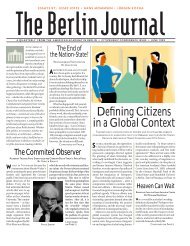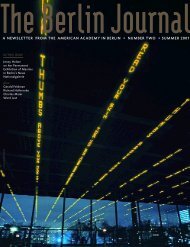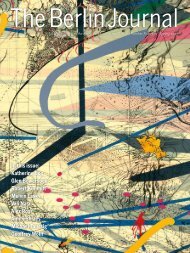Fall 2011 | Issue 21
- No tags were found...
You also want an ePaper? Increase the reach of your titles
YUMPU automatically turns print PDFs into web optimized ePapers that Google loves.
44 | The Berlin Journal | Number Twenty-One | <strong>Fall</strong> <strong>2011</strong><br />
can help to frame minority perspectives in<br />
universal terms that garner broader support.<br />
But ICs cannot impose their own legal<br />
solutions absent the support of domestic<br />
interlocutors.<br />
International judges, like all political<br />
actors, must make a political calculation<br />
about the power and potential of certain<br />
interlocutors. And they must take into<br />
account the counter forces that want the<br />
opposite interpretation. We thus need more<br />
specific conjectures about how ICs make<br />
these calculations and influence outcomes.<br />
It seems reasonable to presume that the<br />
more a government is out of sync with its<br />
domestic constituents, the easier it is for<br />
an IC to figure out what it should do – it<br />
should help domestic allies achieve widely<br />
shared values or help governments resist<br />
the pressure of domestic actors who want<br />
to deviate from international legal agreements.<br />
International human rights law<br />
and international humanitarian law are<br />
especially likely to connect with widespread<br />
sentiments that may be voiced by few but<br />
shared by many.<br />
Less clear is what ICs should do when<br />
the law pushes in a direction that powerful<br />
domestic interests do not like, or<br />
when international law disrupts domestic<br />
constitutional balances. Of course, states<br />
LESS CLEAR IS WHAT INTERNATIONAL COURTS SHOULD DO<br />
WHEN THE LAW PUSHES IN A DIRECTION THAT POWERFUL<br />
DOMESTIC INTERESTS DO NOT LIKE, OR WHEN INTERNATIONAL<br />
LAW DISRUPTS DOMESTIC CONSTITUTIONAL BALANCES.<br />
can withdraw from international treaties,<br />
which would be both a democratic choice<br />
and legally legitimate. But there are other<br />
pathways forward. As the tipping point<br />
argument suggests, international legal<br />
interpretation is a collaborative enterprise.<br />
There is more flexibility in international<br />
law than many presume, and<br />
domestic actors are able to influence IC<br />
decision-making and ensure that international<br />
rules do not undermine cherished<br />
national values. Because states care about<br />
being seen as law-abiding actors, legal<br />
interpretation is able to shape how governments<br />
conceive of their interests and their<br />
options.<br />
This article has suggested that<br />
the advent of powerful international<br />
courts, capable of rulings on state<br />
respect for international law in areas as<br />
diverse as economic law, human rights law,<br />
and war crimes, has its origins in the early<br />
post-war international legal experiments<br />
in Europe. The new international courts<br />
of today are surely not as influential as<br />
Europe’s supranational courts, but I have<br />
suggested that it is a mistake to expect<br />
them to be. We should remember that both<br />
the ecj and ECtHR started out as weak<br />
political institutions, and today’s new ICs<br />
resemble Europe’s ICs of the 1960s and<br />
1970s. The lesson from Europe, therefore,<br />
is that ICs should build political authority<br />
by generating support within national communities<br />
of lawyers, judges, scholars, and<br />
civil servants. This may first require that<br />
an entire generation of senior judges and<br />
law professors retire, and that young law<br />
CHRONIST DES<br />
ZEITGESCHEHENS.<br />
PHOENIX produziert seit vielen Jahren in der<br />
American Academy die erfolgreiche Reihe<br />
KAMINGESPRÄCH mit Jörg Schönenborn (ARD)<br />
und Elmar Theveßen (ZDF).<br />
DER EREIGNIS- UND<br />
DOKUMENTATIONSKANAL<br />
VON ARD UND ZDF<br />
Empfangbar über Satellit ASTRA 1L, Transp. 36 (analog), ASTRA 1KR, Transp. 51 (digital)<br />
sowie über Kabel (analog und digital) und DVB-T<br />
PHOENIX.DE<br />
Anzeige_Phoenix_185x124_v2.indd 1 08.09.11 15:45



